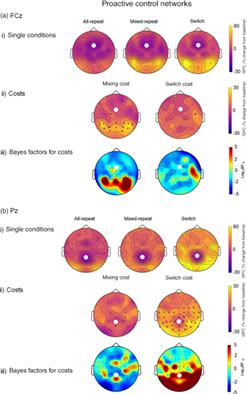当前位置:
X-MOL 学术
›
Hum. Brain Mapp.
›
论文详情
Our official English website, www.x-mol.net, welcomes your
feedback! (Note: you will need to create a separate account there.)
Dissociable theta networks underlie the switch and mixing costs during task switching
Human Brain Mapping ( IF 3.5 ) Pub Date : 2021-06-29 , DOI: 10.1002/hbm.25573 Montana McKewen 1, 2, 3 , Patrick S Cooper 4 , Patrick Skippen 1, 2, 5 , Aaron S W Wong 1, 3 , Patricia T Michie 1, 2 , Frini Karayanidis 1, 2, 3
Human Brain Mapping ( IF 3.5 ) Pub Date : 2021-06-29 , DOI: 10.1002/hbm.25573 Montana McKewen 1, 2, 3 , Patrick S Cooper 4 , Patrick Skippen 1, 2, 5 , Aaron S W Wong 1, 3 , Patricia T Michie 1, 2 , Frini Karayanidis 1, 2, 3
Affiliation

|
During task-switching paradigms, both event-related potentials and time-frequency analyses show switch and mixing effects at frontal and parietal sites. Switch and mixing effects are associated with increased power in broad frontoparietal networks, typically stronger in the theta band (~4–8 Hz). However, it is not yet known whether mixing and switch costs rely upon common or distinct networks. In this study, we examine proactive and reactive control networks linked to task switching and mixing effects, and whether strength of connectivity in these networks is associated with behavioural outcomes. Participants (n = 197) completed a cued-trials task-switching paradigm with concurrent electroencephalography, after substantial task practice to establish strong cue-stimulus–response representations. We used inter-site phase clustering, a measure of functional connectivity across electrode sites, to establish cross-site connectivity from a frontal and a parietal seed. Distinct theta networks were activated during proactive and reactive control periods. During the preparation interval, mixing effects were associated with connectivity from the frontal seed to parietal sites, and switch effects with connectivity from the parietal seed to occipital sites. Lateralised occipital connectivity was common to both switch and mixing effects. After target onset, frontal and parietal seeds showed a similar pattern of connectivity across trial types. These findings are consistent with distinct and common proactive control networks and common reactive networks in highly practised task-switching performers.
中文翻译:

可分离的 theta 网络是任务切换期间切换和混合成本的基础
在任务切换范式中,事件相关电位和时频分析都显示了额叶和顶叶部位的切换和混合效应。切换和混合效应与广泛的额顶网络中的功率增加有关,通常在 theta 波段(~4-8 Hz)中更强。然而,目前尚不清楚混合和转换成本是否依赖于共同或不同的网络。在这项研究中,我们检查了与任务切换和混合效应相关的主动和被动控制网络,以及这些网络中的连接强度是否与行为结果相关。参与者(n = 197)在大量任务实践以建立强大的提示-刺激-响应表示之后,完成了具有并发脑电图的提示试验任务切换范例。我们使用站点间相位聚类(一种跨电极站点的功能连接性度量)来建立来自额叶和顶叶种子的跨站点连接。在主动和被动控制期间激活了不同的 theta 网络。在准备间隔期间,混合效应与从额叶种子到顶叶部位的连接有关,而开关效应与从顶叶种子到枕叶部位的连接有关。侧向枕骨连接对于切换和混合效果都很常见。目标开始后,额叶和顶叶种子在试验类型中显示出类似的连接模式。
更新日期:2021-09-02
中文翻译:

可分离的 theta 网络是任务切换期间切换和混合成本的基础
在任务切换范式中,事件相关电位和时频分析都显示了额叶和顶叶部位的切换和混合效应。切换和混合效应与广泛的额顶网络中的功率增加有关,通常在 theta 波段(~4-8 Hz)中更强。然而,目前尚不清楚混合和转换成本是否依赖于共同或不同的网络。在这项研究中,我们检查了与任务切换和混合效应相关的主动和被动控制网络,以及这些网络中的连接强度是否与行为结果相关。参与者(n = 197)在大量任务实践以建立强大的提示-刺激-响应表示之后,完成了具有并发脑电图的提示试验任务切换范例。我们使用站点间相位聚类(一种跨电极站点的功能连接性度量)来建立来自额叶和顶叶种子的跨站点连接。在主动和被动控制期间激活了不同的 theta 网络。在准备间隔期间,混合效应与从额叶种子到顶叶部位的连接有关,而开关效应与从顶叶种子到枕叶部位的连接有关。侧向枕骨连接对于切换和混合效果都很常见。目标开始后,额叶和顶叶种子在试验类型中显示出类似的连接模式。











































 京公网安备 11010802027423号
京公网安备 11010802027423号